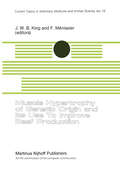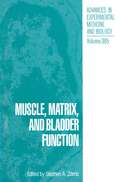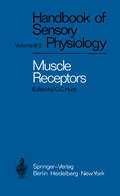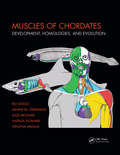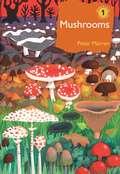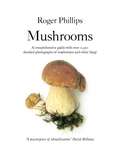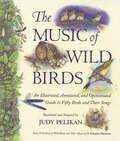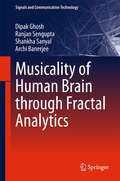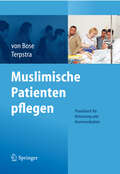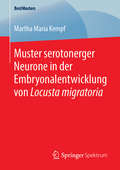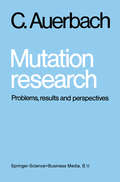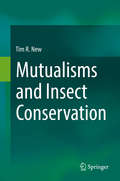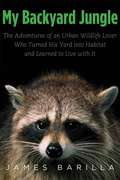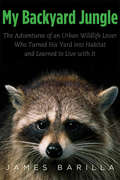- Table View
- List View
Muscle Hypertrophy of Genetic Origin and its use to Improve Beef Production: A Seminar in the CEC Programme of Coordination of Research on Beef Production held in Toulouse, France, June 1–12, 1980 (Current Topics in Veterinary Medicine #16)
by J. W. B. King F. MénissierThis publication contains the proceedings of a seminar held in Toulouse, France, on 10th, 11th and 12th June 1980, under the auspices of the Commission of the European Communities, Directorate General for Agriculture, Division for the Coordination of Agricultural Research, as part of a programme of research on beef production. The seminar was intended to bring together available experience on the utilisation of hereditary muscular hypertrophy for meat production in the member states of the European Communities. Although the phenomenon of double muscling has been exploited in various countries, particularly France, Italy and Belgium, different breeds are used and different methods of exploitation employed. An attempt was therefore made to bring together the collective experience of participants. Contributions ranged from those on the inheritance of muscular hypertrophy to alternative production systems and from fundamental studies of muscle growth to practical ways of selling the additional musrile found in animals with muscular hypertrophy. The collection of assembled papers and discussions thus represents one of the most extensive reviews of the subject that has been attempted.
Muscle, Matrix, and Bladder Function (Advances in Experimental Medicine and Biology #385)
by Stephen A. ZdericThis conference and monograph were the result of many collective efforts. The whole concept was formulated one early Wednesday morning at our weekly research meeting at Children's Hospital in our division of urology. We have been most fortunate to have a close collaboration with Bob Levin, Ed Macarak, and Pam Howard who have helped steer the course of our division's growing interest in basic science. At our weekly meetings our laboratory fellow will summarize their current work. Other ongoing areas of investigation in our labs and elsewhere are discussed. We have always made an effort to try and understand what other groups are doing who are working in the area of bladder smooth muscle research. It occurred to us that the best way to really know what everyone working in this field was doing would be to sponsor a 2-day meeting where we could all gather to discuss our ongoing work. A major limitation of the annual meeting of the American Urologic Association or the urology section of the American Academy of Pediatrics is that the scientfic sessions are limited as these are meant to be primarily clinical meetings (as they should be). For this reason the idea of a meeting devoted solely to research about the urinary bladder had great appeal. In addition to allowing for longer presentations than the standard 5 to 7 minutes, every effort would be made to encourage a dialogue amongst the presenters and the audience.
Muscle Receptors (Handbook of Sensory Physiology #3 / 2)
by D. Barker C.C. Hunt A.K. McIntyreThis section will consider the structure and function of muscle receptors, as well as the central nervous system mechanisms with which they are concerned. In volume I of this Handbook, receptor mechanisms are discussed in detail. Also, the crustacean stretch receptor and the frog muscle spindle have been considered. The present section will be concerned with vertebrate muscle receptors with an emphasis on mammals. Muscle receptors provide interesting examples of specialized mechanorecep tors. The muscle spindle is a striking case of a receptor which is regulated in its function by the central nervous system in efferent neurons. Muscle receptors have long been known to playa crucial role in the reflex regulation of movement. In recent years it has become apparent that these receptors are also important in sensory phenomena such as the perception of position and movement. St. Louis, July 1974 c.c. HUNT Contents Chapter I The Morphology of Muscle Receptors. By D. BARKER. With 99 Figures . . . . . . . . . . . . . . . .. 1 Chapter II The Physiology of Muscle Receptors. By C.C. HUNT. With 21 Figures . . . . . . . . . . . . . . . . . 191 Chapter III Central Actions of Impulses in Muscle Afferent Fibres. By A. K. McINTYRE. With 8 Figures 235 Author Index 289 Subject Index 299 List of Contributors BARKER, David Department of Zoology, University of Durham, Science Laboratories, South Road, Durham DH1 3LE, Great Britain HUNT, Carlton C. Department of Physiology and Biophysics, Washington University, School of Medicine, 660 South Euclid Avenue, St. Louis, Mo. 63110, USA McINTYRE, A. K.
Muscle Receptors and Movement: Proceedings of a Symposium held at the Sherrington School of Physiology, St Thomas’s Hospital Medical School, London, on July 8th and 9th, 1980
by A. Taylor A. ProchazkaMuscles of Chordates: Development, Homologies, and Evolution
by Rui Diogo Janine M. Ziermann Julia Molnar Natalia Siomava Virginia AbdalaChordates comprise lampreys, hagfishes, jawed fishes, and tetrapods, plus a variety of more unfamiliar and crucially important non-vertebrate animal lineages, such as lancelets and sea squirts. This will be the first book to synthesize, summarize, and provide high-quality illustrations to show what is known of the configuration, development, homology, and evolution of the muscles of all major extant chordate groups. Muscles as different as those used to open the siphons of sea squirts and for human facial communication will be compared, and their evolutionary links will be explained. Another unique feature of the book is that it covers, illustrates, and provides detailed evolutionary tables for each and every muscle of the head, neck and of all paired and median appendages of extant vertebrates. Key Selling Features: Has more than 200 high-quality anatomical illustrations, including evolutionary trees that summarize the origin and evolution of all major muscle groups of chordates Includes data on the muscles of the head and neck and on the pectoral, pelvic, anal, dorsal, and caudal appendages of all extant vertebrate taxa Examines experimental observations from evolutionary developmental biology studies of chordate muscle development, allowing to evolutionarily link the muscles of vertebrates with those of other chordates Discusses broader developmental and evolutionary issues and their implications for macroevolution, such as the links between phylogeny and ontogeny, homology and serial homology, normal and abnormal development, the evolution, variations, and birth defects of humans, and medicine.
Muscles of Chordates: Development, Homologies, and Evolution
by Rui Diogo Janine M. Ziermann Julia Molnar Natalia Siomava Virginia AbdalaChordates comprise lampreys, hagfishes, jawed fishes, and tetrapods, plus a variety of more unfamiliar and crucially important non-vertebrate animal lineages, such as lancelets and sea squirts. This will be the first book to synthesize, summarize, and provide high-quality illustrations to show what is known of the configuration, development, homology, and evolution of the muscles of all major extant chordate groups. Muscles as different as those used to open the siphons of sea squirts and for human facial communication will be compared, and their evolutionary links will be explained. Another unique feature of the book is that it covers, illustrates, and provides detailed evolutionary tables for each and every muscle of the head, neck and of all paired and median appendages of extant vertebrates. Key Selling Features: Has more than 200 high-quality anatomical illustrations, including evolutionary trees that summarize the origin and evolution of all major muscle groups of chordates Includes data on the muscles of the head and neck and on the pectoral, pelvic, anal, dorsal, and caudal appendages of all extant vertebrate taxa Examines experimental observations from evolutionary developmental biology studies of chordate muscle development, allowing to evolutionarily link the muscles of vertebrates with those of other chordates Discusses broader developmental and evolutionary issues and their implications for macroevolution, such as the links between phylogeny and ontogeny, homology and serial homology, normal and abnormal development, the evolution, variations, and birth defects of humans, and medicine.
Mushrooms: The natural and human world of British fungi (British Wildlife Collection)
by Peter MarrenMushrooms, the first of a major new series of books on British natural history, provides a remarkable insight into the natural and human world of fungi. Peter Marren, in his inimitable, relaxed style, guides the reader through the extraordinary riches of this often overlooked group, from the amazing diversity of forms and lifestyles that populate the fungal landscape, to the pursuit of edible fungi for the pot, and the complexities of identification thrown up by our modern understanding of DNA. Throughout the book, the author tells a story rich in detail about how we have come to appreciate and, in some cases, fear the mushrooms and toadstools that are such an integral part of the changing seasons. Marren also provides a refreshingly candid view of our attempts to name species, the role of fungi in ecosystems, and our recent efforts to record and conserve them.
Mushrooms: The natural and human world of British fungi (British Wildlife Collection)
by Peter MarrenMushrooms, the first of a major new series of books on British natural history, provides a remarkable insight into the natural and human world of fungi. Peter Marren, in his inimitable, relaxed style, guides the reader through the extraordinary riches of this often overlooked group, from the amazing diversity of forms and lifestyles that populate the fungal landscape, to the pursuit of edible fungi for the pot, and the complexities of identification thrown up by our modern understanding of DNA. Throughout the book, the author tells a story rich in detail about how we have come to appreciate and, in some cases, fear the mushrooms and toadstools that are such an integral part of the changing seasons. Marren also provides a refreshingly candid view of our attempts to name species, the role of fungi in ecosystems, and our recent efforts to record and conserve them.
Mushrooms: A comprehensive guide to mushroom identification (A\pan Original Ser.)
by Roger Phillips'Roger Phillips has written the best mushroom book I know.' Hugh Fearnley-WhittingstallThe culmination of over thirty years' work, Roger Phillips's authoritative and superbly illustrated reference work is packed with the most up-to-date information and original photographs. The essential illustrated mycological encyclopedia, this book is also clear, user friendly and will appeal to a wide range of readers. Unsurpassed in both illustrative and descriptive detail, Mushrooms contains over 1,250 photographs, often showing the specimens in various stages of growth, and includes all the latest botanical and common names as well as current ecological information on endangered species. Having sold more than 750,000 copies in Europe of his previous title on mushrooms, Roger Phillips's Mushrooms once again sets the benchmark. Quite simply, nobody with an interest in the subject can afford to be without this book.
The Music of Wild Birds: An Illustrated, Annotated, and Opinionated Guide to Fifty Birds and Their Songs
by Judy PelikanOne hundred years ago, F. Schuyler Mathews, an erudite naturalist and birder, theorized that birds sing first for love of music, and second for love of the lady. To expand on his theory, he actually scored the songs of birds in the wild. His charming text and bird-by-bird annotations were compiled into a guide called Field Book of Wild Birds and Their Music. This extraordinary work has now been lavishly illustrated and adapted for a new audience. Each bird is meticulously rendered by artist Judy Pelikan in full-color illustrations that feature not only the birds, but also their nests, eggs, and feathers. And every song is represented by its written musical score, which Mathews expertly explains in a way that both musicians and non-musicians can enjoy. As Mathews points out, the music of wild birds is everywhere--in poems, children's nursery songs, as well as in the works of the great composers: the Black-billed Cuckoo's call appears near the close of Beethoven's Pastoral Symphony; the Nashville Warbler's song is found in the opening bars of Rossini's Carovale, and the Meadowlark's song is remarkably like the first two bars of Alfredo's song in La Traviata. He reveals how a bird's character is reflected in its song: the Baltimore Oriole is a sharp-billed, sharp-witted character, and his remarks are as incisive and crisp as the toots of a steam whistle. And he reminds us of the words of our great poets--Wordsworth, Emerson, Sir Walter Scott--and their descriptions of the very same birds and their music. This classic, useful, and completely original guide will put a song into the heart of novice and experienced birder alike.
Musicality of Human Brain through Fractal Analytics (Signals and Communication Technology)
by Dipak Ghosh Ranjan Sengupta Shankha Sanyal Archi BanerjeeThis book provides a comprehensive overview of how fractal analytics can lead to the extraction of interesting features from the complex electroencephalograph (EEG) signals generated by Hindustani classical music. It particularly focuses on how the brain responses to the emotional attributes of Hindustani classical music that have been long been a source of discussion for musicologists and psychologists. Using robust scientific techniques that are capable of looking into the most intricate dynamics of the complex EEG signals, it deciphers the human brain’s response to different ragas of Hindustani classical music, shedding new light on what happens inside the performer’s brain when they are mentally composing the imagery of a particular raga. It also explores the much- debated issue in the musical fraternity of whether there are any universal cues in music that make it identifiable for people throughout the world, and if so, what are the neural correlates associated with the universal cues? This book is of interest to researchers and scholars of music and the brain, nonlinear science, music cognition, music signal processing and music information retrieval. In addition, researchers in the field of nonlinear biomedical signal processing and music signal analysis benefit from this book.
The Muskellunge Symposium: A Memorial Tribute to E.J. Crossman (Developments in Environmental Biology of Fishes #26)
by James S. Diana Terry L. MargenauThis book documents proceedings of a symposium on muskellunge developed as a memorial for E.J. Crossman. It focuses on the biology, ecology, and management of muskellunge, Ed’s favorite fish. The papers include surveys of current ecological, behavioral, and management-related issues for muskellunge fisheries. The symposium was developed to bring researchers and anglers together, and was sponsored by Muskies, Inc.
MuskelRevolution: Konzepte und Rezepte zum Muskel- und Kraftaufbau
by Marco ToigoDurch wissenschaftlich fundierte Erkenntnisse können Entscheidungen zum Erhalt und zur Steigerung der eigenen Leistungsfähigkeit und Gesundheit getroffen werden. Dieses Werk führt den Leser auf anschauliche und unterhaltsame Weise von den naturwissenschaftlichen Erkenntnissen der Muskelforschung zu wertvollen Praxisempfehlungen für die individuelle Trainingsgestaltung und -durchführung. Dabei werden sowohl Begriffsverwirrungen entrümpelt, gängige Mythen und Empfehlungen hinterfragt und Denkfehler entlarvt. So richtet sich dieses Buch an alle, die wissen möchten, wie sie ihre Muskelkraft und -masse effektiv und effizient steigern können, gleichzeitig aber auch verstehen möchten, wie die Empfehlungen wissenschaftlich begründet sind.
Muslimische Patienten pflegen: Praxisbuch für Betreuung und Kommunikation
by Alexandra Bose Jeanette TerpstraIn Deutschland leben ca. 4 Millionen Muslime und die Zahl der älteren Migranten steigt. So versorgen beruflich Pflegende immer häufiger kranke und pflegebedürftige Menschen, die einen anderen kulturellen Hintergrund haben. In der medizinischen und pflegerischen Betreuung kommt es zwischen Migranten und Pflegepersonal durch die kulturellen Unterschiede oft zu Konfliktsituationen und Störungen im Behandlungs- und Stationsablauf. Auslöser sind Stereotype, Unwissenheit und Verständigungsschwierigkeiten.Die Autorinnen unterstützen mit dieser Praxisfibel einen konfliktfreien Umgang mit muslimischen Migranten. An einzelnen Fallsituationen aus dem Klinik- und Pflegealltag werden Probleme dargestellt, kulturelle Hintergründe erläutert und Handlungsanregungen vorgeschlagen. Pflegende erhalten konkrete Tipps wie sie häufig auftretende Stress- und Konfliktsituationen mit muslimischen Patienten meistern. Das Kapitel über die Grundlagen der islamischen Kultur, z.B. zum Wertesystem, Rituale, Rollenverhalten, Krankheitsverständnis, fördert das Verständnis für die andere Kultur und hilft Konflikten vorzubeugen. Einfach und praktisch: Ein speziell entwickelter Anamnesebogen für muslimische Patienten erleichtert es Pflegenden schon bei der Aufnahme auf die besonderen Bedürfnisse einzugehen und eine konfliktfreie Betreuung in der Einrichtung vorzubereiten. Ein Glossar erläutert die wichtigsten islamischen Begriffe. Für beruflich Pflegende im Krankenhaus und in Pflegeeinrichtungen, die sich auf die Bedürfnisse von Migranten einlassen möchten. Geeignet für die interne Fortbildung, die Praxisanleitung aber auch für den Sozialdienst und ehrenamtliche Besuchsdienste.
Muster serotonerger Neurone in der Embryonalentwicklung von Locusta migratoria (BestMasters)
by Martha Maria KempfDie phylogenetischen Beziehungen innerhalb des Stamms der Arthropoda sind noch immer nicht eindeutig geklärt. Da Arthropoden eine geringe Anzahl homologer, serotonerger Neurone enthalten, können sie für phylogenetische Vergleiche herangezogen werden. Die europäische Wanderheuschrecke Locusta migratoria dient als Modellorganismus für die Klasse der Insekten. Martha Maria Kempf untersucht das Muster serotonerger Neurone in der ventralen Ganglienkette während der Embryonalentwicklung von L. migratoria. Mithilfe immuncytochemischer Markierungen von Serotonin ermittelt sie, ab welchem Entwicklungsstadium im Embryo die posterioren Cluster serotonerger Neurone auftreten. Dies soll erste Hinweise liefern, wann diese Zellen in der Embryonalentwicklung entstehen und woher sie abstammen können. Die beschriebenen Ergebnisse und Erkenntnisse sind auch für Evolutionsbiologen, Entwicklungsbiologen und Physiologen interessant, da der Neurotransmitter Serotonin im ganzen Tierreich in den verschiedensten Organsystemen weit verbreitet ist, einschließlich der emotionalen Steuerung bei Säugetieren und Menschen.
Mutagenesis of the Mouse Genome (Georgia Genetics Review #2)
by Monica Justice Mary BedellThe Second Georgia Genetics Symposium was held color. Soon after, he joined the sta? of The Jackson in September 2000, and the development of this Laboratory in Bar Harbor, Maine. book took place over the nearly 4 years that ensued. Much of Bill’s research at the lab was centered During this time, many advances in the Genome around investigating phenotypic variability within Project and mouse mutagenesis were made. In the highly inbred strains, and in that connection he book overview, we discuss the development of the developed the technique of ovarian transplanta- Genome Project (which is the context for the sym- tion (even using embryonic donors) and a genetic posium), the role the mouse was playing at that scheme whereby graft compatibility could be time, how that role has evolved, and how the combined with the ability to distinguish o?spring chapters of the book address issues in mouse func- from donor and regenerated host ovaries. His tional genetics. Many of the chapters in this book work was in?uenced by the second World War, will provide useful resources for years to come. ?rst because The Jackson Laboratory turned into Of greater impact, our keynote speaker, the a production colony for the military, primarily to mutagenesis pioneer William L. (Bill) Russell, produce mice for typhoid testing, and secondly, passed away on July 23, 2003.
Mutation and Evolution (Contemporary Issues in Genetics and Evolution #7)
by Ronny C. Woodruff James N. ThompsonAlthough debated since the time of Darwin, the evolutionary role of mutation is still controversial. In over 40 chapters from leading authorities in mutation and evolutionary biology, this book takes a new look at both the theoretical and experimental measurement and significance of new mutation. Deleterious, nearly neutral, beneficial, and polygenic mutations are considered in their effects on fitness, life history traits, and the composition of the gene pool. Mutation is a phenomenon that draws attention from many different disciplines. Thus, the extensive reviews of the literature will be valuable both to established researchers and to those just beginning to study this field. Through up-to-date reviews, the authors provide an insightful overview of each topic and then share their newest ideas and explore controversial aspects of mutation and the evolutionary process. From topics like gonadal mosaicism and mutation clusters to adaptive mutagenesis, mutation in cell organelles, and the level and distribution of DNA molecular changes, the foundation is set for continuing the debate about the role of mutation, fitness, and adaptability. It is a debate that will have profound consequences for our understanding of evolution.
Mutation research: Problems, results and perspectives
by Charlotte AuerbachThis book is intended for the senior undergraduate (Honours student) in genetics, and for the postgraduate who wants a survey of the whole field or information on a special area within it. In order to cater for readers with such different requirements, I have made the list of references unusually large for a textbook. It includes classical papers as well as very recent ones (to the end of 1974); reviews as well as specialized articles; elementary expositions from Scientific American as well as highly technical papers from journals on genetics and molecular biology. In areas of active research, I have given preference to the latest references, which will lead the reader to earlier ones. In addition to the references at the end of each chapter, a bibliography at the end of the book lists relevant books and general reviews. Apart from the first chapter, the book is not written as a history of mutation research; but throughout I have tried to emphasize the continuity of the problems, concepts and ideas. The reader will find many examples of this. Muller's once famous and then almost forgotten classification of genes by their action has now been given biochemical reality by studies of gene action in vitro. The problem of whether mutations can arise in non-replicating genomes is one of the oldest in mutation research; yet an unequivocal solution was obtained only recently with bacteriophage.
Mutations in Man
by G. ObeThis year we remember the 39th anniversary of the atomic bomb explo sions in Hiroshima and Nagasaki, which led to the exposure of thou sands of people to high doses of ionizing radiations. Nearly 18 years earlier, on the 15th of September, 1927, H. J. Muller presented his paper The Problem of Genic Modification at the Fifth International Congress of Genetics in Berlin, in which he brilliantly demonstrated the muta genic activity of X-rays. In 1928, K. H. Bauer formulated his mutation theory of the origin of cancer, and already in 1914, Th. Boveri speculat ed that tumor cells originate from an abnormal chromosomal comple ment. In the meantime we have learned that also nonionizing radiation and an immense number of environmental chemicals, both, man-made and naturally occurring, are mutagenic in a variety of test systems, in cluding human cells. In no case has it been shown unequivocally that physical or chemical mutagens have led to an elevation of the mutation rate in the germ cells of man, but in view of the huge body of experi mental data this seems to be a problem of detection. It can be expect ed that germ cell mutations are induced as a consequence of exposure to mutagens in man, as yet undetectable with the methods at hand. An uncontrolled addition of mutations to the human gene pool may well have unforeseen and catastrophic consequences in future genera tions for whom we should feel responsible.
Mutualisms and Insect Conservation
by Tim R. NewDocumenting and understanding intricate ecological interactions involving insects is a central need in conservation, and the specialised and specific nature of many such associations is displayed in this book. Their importance is exemplified in a broad global overview of a major category of interactions, mutualisms, in which the interdependence of species is essential for their mutual wellbeing. The subtleties that sustain many mutualistic relationships are still poorly understood by ecologists and conservation managers alike. Examples from many parts of the world and ecological regimes demonstrate the variety of mutualisms between insect taxa, and between insects and plants, in particular, and their significance in planning and undertaking insect conservation – of both individual species and the wider contexts on which they depend. Several taxonomic groups, notably ants, lycaenid butterflies and sucking bugs, help to demonstrate the evolution and flexibility of mutualistic interactions, whilst fundamental processes such as pollination emphasise the central roles of, often, highly specific partnerships. This compilation brings together a wide range of relevant cases and contexts, with implications for practical insect conservation and increasing awareness of the roles of co-adaptations of behaviour and ecology as adjuncts to designing optimal conservation plans. The three major themes deal with the meanings and mechanisms of mutualisms, the classic mutualisms that involve insect partners, and the environmental and conservation lessons that flow from these and have potential to facilitate and improve insect conservation practice. The broader ecological perspective advances the transition from primary focus on single species toward consequently enhancing wider ecological contexts in which insect diversity can thrive.
My Autobiography
by A.P. McCoyThe fully updated autobiography of Tony 'A.P.' McCoy, Grand National and BBC SPORTS PERSONALITY OF THE YEAR winner and unquestionably the greatest jump jockey ever.Tony 'A.P.' McCoy is without doubt the greatest and most successful jump jockey of all time. He has collected a record 16 consecutive jump-jockey titles to date, since 1992 he has ridden more than 3,000 winners, saying 'I never stop dreaming of the day I'll reach 4,000', and in 2002 he beat Sir Gordon Richards's record of 269 winners in a season by riding 289. In April 2010, A.P. achieved his lifelong ambition when he won the Grand National at Aintree on Don't Push It. It was his 15th attempt to win the race, a victory that captured the public's imagination and further enhanced a glittering career in which he had seemingly won all there was to win. It was the missing piece in the racing jigsaw for a champion jockey who had already had famous victories in the King George VI Chase, Champion Hurdle, Champion Chase and Cheltenham Gold Cup.This powerfully honest autobiography looks at life at the very top in National Hunt racing, and includes the highs and lows of A.P. winning his second Gold Cup, in 2012 on Synchronised, fifteen years after his first, only to see the horse put down after a fall in that year's Grand National.These are the memoirs of a true champion, an icon of sport, whose astonishing achievements are unlikely to be surpassed. It is a great story of courage and modesty, pain and professional setbacks, strong family values and sporting triumphs, the good guy coming first - and staying there.
My Backyard Jungle: The Adventures of an Urban Wildlife Lover Who Turned His Yard into Habitat and Learned to Live with It
by James BarillaFor James Barilla and his family, the dream of transforming their Columbia, South Carolina, backyard into a haven for wildlife evoked images of kids catching grasshoppers by day and fireflies at night, of digging up potatoes and picking strawberries. When they signed up with the National Wildlife Federation to certify their yard as a wildlife habitat, it felt like pushing back, in however small a way, against the tide of bad news about vanishing species, changing climate, dying coral reefs. Then the animals started to arrive, and Barilla soon discovered the complexities (and possible mayhem) of merging human with animal habitats. What are the limits of coexistence, he wondered? To find out, Barilla set out across continents to explore cities where populations of bears, monkeys, marmosets, and honeybees live alongside human residents. My Backyard Jungle brings these unique stories together, making Barilla’s yard the centerpiece of a meditation on possibilities for coexistence with animals in an increasingly urban world. Not since Gerald Durrell penned My Family and Other Animals have readers encountered a naturalist with such a gift for storytelling and such an open heart toward all things wild.
My Backyard Jungle: The Adventures of an Urban Wildlife Lover Who Turned His Yard into Habitat and Learned to Live with It
by James BarillaFor James Barilla and his family, the dream of transforming their Columbia, South Carolina, backyard into a haven for wildlife evoked images of kids catching grasshoppers by day and fireflies at night, of digging up potatoes and picking strawberries. When they signed up with the National Wildlife Federation to certify their yard as a wildlife habitat, it felt like pushing back, in however small a way, against the tide of bad news about vanishing species, changing climate, dying coral reefs. Then the animals started to arrive, and Barilla soon discovered the complexities (and possible mayhem) of merging human with animal habitats. What are the limits of coexistence, he wondered? To find out, Barilla set out across continents to explore cities where populations of bears, monkeys, marmosets, and honeybees live alongside human residents. My Backyard Jungle brings these unique stories together, making Barilla’s yard the centerpiece of a meditation on possibilities for coexistence with animals in an increasingly urban world. Not since Gerald Durrell penned My Family and Other Animals have readers encountered a naturalist with such a gift for storytelling and such an open heart toward all things wild.
My Backyard Jungle: The Adventures of an Urban Wildlife Lover Who Turned His Yard into Habitat and Learned to Live with It
by James BarillaFor James Barilla and his family, the dream of transforming their Columbia, South Carolina, backyard into a haven for wildlife evoked images of kids catching grasshoppers by day and fireflies at night, of digging up potatoes and picking strawberries. When they signed up with the National Wildlife Federation to certify their yard as a wildlife habitat, it felt like pushing back, in however small a way, against the tide of bad news about vanishing species, changing climate, dying coral reefs. Then the animals started to arrive, and Barilla soon discovered the complexities (and possible mayhem) of merging human with animal habitats. What are the limits of coexistence, he wondered? To find out, Barilla set out across continents to explore cities where populations of bears, monkeys, marmosets, and honeybees live alongside human residents. My Backyard Jungle brings these unique stories together, making Barilla’s yard the centerpiece of a meditation on possibilities for coexistence with animals in an increasingly urban world. Not since Gerald Durrell penned My Family and Other Animals have readers encountered a naturalist with such a gift for storytelling and such an open heart toward all things wild.
